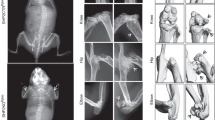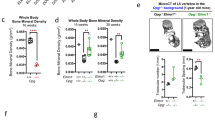Abstract
The hematopoietic-restricted protein Src homology 2–containing inositol-5-phosphatase (SHIP) blunts phosphatidylinositol-3-kinase-initiated signaling by dephosphorylating its major substrate, phosphatidylinositol-3,4,5-trisphosphate. As SHIP−/− mice contain increased numbers of osteoclast precursors, that is, macrophages, we examined bones from these animals and found that osteoclast number is increased two-fold. This increased number is due to the prolonged life span of these cells and to hypersensitivity of precursors to macrophage colony-stimulating factor (M-CSF) and receptor activator of nuclear factor-κB ligand (RANKL). Similar to pagetic osteoclasts, SHIP−/− osteoclasts are enlarged, containing upwards of 100 nuclei, and exhibit enhanced resorptive activity. Moreover, as in Paget disease, serum levels of interleukin-6 are markedly increased in SHIP−/− mice. Consistent with accelerated resorptive activity, 3D trabecular volume fraction, trabecular thickness, number and connectivity density of SHIP−/− long bones are reduced, resulting in a 22% loss of bone-mineral density and a 49% decrease in fracture energy. Thus, SHIP negatively regulates osteoclast formation and function and the absence of this enzyme results in severe osteoporosis.
This is a preview of subscription content, access via your institution
Access options
Subscribe to this journal
Receive 12 print issues and online access
$209.00 per year
only $17.42 per issue
Buy this article
- Purchase on Springer Link
- Instant access to full article PDF
Prices may be subject to local taxes which are calculated during checkout






Similar content being viewed by others
References
Liu, L. et al. The Src homology 2 (SH2) domain of SH2-containing inositol phosphatase (SHIP) is essential for tyrosine phosphorylation of SHIP, its association with Shc, and its induction of apoptosis. J. Biol. Chem. 272, 8983–8998 (1997).
Krystal, G. Lipid phosphatases in the immune system. Semin. Immunol. 12, 397–403 (2000).
Rohrschneider, L.R., Fuller, J.F., Wolf, I., Liu, Y. & Lucas, D.M. Structure, function, and biology of SHIP proteins. Genes Dev. 14, 505–520 (2000).
Huber, M. et al. The src homology 2-containing inositol phosphatase (SHIP) is the gatekeeper of mast cell degranulation. Proc. Natl. Acad. Sci. USA 95, 11330–11335 (1998).
Damen, J.E. et al. The 145-kDa protein induced to associate with Shc by multiple cytokines is an inositol tetraphosphate and phosphatidylinositol 3,4,5-triphosphate 5-phosphatase. Proc. Natl. Acad. Sci. USA 93, 1689–1693 (1996).
Ibbotson, K.J., Roodman, G.D., McManus, L.M. & Mundy, G.R. Identification and characterization of osteoclast-like cells and their progenitors in cultures of feline marrow mononuclear cells. J. Cell Biol. 99, 471–480 (1984).
Tondravi, M.M. et al. Targeted deletion of PU.1 induces osteopetrosis rescuable by bone marrow transplantation. Nature 386, 81–84 (1997).
Teitelbaum, S.L. Bone resorption by osteoclasts. Science 289, 1504–1508 (2000).
Kodama, H., Nose, M., Niida, S. & Yamasaki, A. Essential role of macrophage colony-stimulating factor in the osteoclast differentiation supported by stromal cells. J. Exp. Med. 173, 1291–1294 (1991).
Wong, B.R. et al. TRANCE is a novel ligand of the tumor necrosis factor receptor family that activates c-Jun N-terminal kinase in T cells. J. Biol. Chem. 272, 25190–25194 (1997).
Yasuda, H. et al. Osteoclast differentiation factor is a ligand for osteoprotegerin/osteoclastogenesis-inhibitory factor and is identical to TRANCE/RANKL. Proc. Natl. Acad. Sci. USA 95, 3597–3602 (1998).
Lacey, D.L. et al. Osteoprotegerin ligand is a cytokine that regulates osteoclast differentiation and activation. Cell 93, 165–176 (1998).
Anderson, D.M. et al. A homologue of the TNF receptor and its ligand enhance T-cell growth and dendritic-cell function. Nature 390, 175–179 (1997).
Kong, Y.Y. et al. OPGL is a key regulator of osteoclastogenesis, lymphocyte development and lymph-node organogenesis. Nature 397, 315–323 (1999).
Helgason, C.D. et al. Targeted disruption of SHIP leads to hemopoietic perturbations, lung pathology, and a shortened life span. Genes Dev. 12, 1610–1620 (1998).
Teitelbaum, S.L. Metabolic and other non-tumorous disorders of bone. in Pathology, 7th edn (eds. Anderson, W.A.D. & Kissane, J.M.) 1905–1977 (C.V. Mosby Company, St. Louis, 1977).
Hosking, D.J. Paget's disease of bone. Br. Med. J (Clin. Res. Ed.) 283, 686–688 (1981).
Roodman, G.D. Paget's disease and osteoclast biology. Bone 19, 209–212 (1996).
Horowitz, M.C. & Lorenzo, J.A. Local regulators of bone: IL-1, TNF, lymphotoxin, interferon-γ, IL-8, IL-10, IL-4, the LIF/IL-6 family and additional cytokines. in Principles of Bone Biology, 2nd edn (eds. Bilezikian, J.P., Raisz, L.G. & Rodan, G.A.) 961–977 (Academic Press, San Diego, 2002).
Cantley, L.C. Translocating tubby. Science 292, 2019–2021 (2001).
Hurley, J.H. & Meyer, T. Subcellular targeting by membrane lipids. Curr. Opin. Cell Biol. 13, 146–152 (2001).
Xu, Y., Seet, L.F., Hanson, B. & Hong, W. The Phox homology (PX) domain, a new player in phosphoinositide signalling. Biochem. J. 360, 513–530 (2001).
Simpson, L. & Parsons, R. PTEN: Life as a tumor suppressor. Exp. Cell Res. 264, 29–41 (2001).
Nandurkar, H.H. et al. Characterization of an adapter subunit to a phosphatidylinositol (3)P 3-phosphatase: Identification of a myotubularin-related protein lacking catalytic activity. Proc. Natl. Acad. Sci. USA 98, 9499–9504 (2001).
Clement, S. et al. The lipid phosphatase SHIP2 controls insulin sensitivity. Nature 409, 92–97 (2001).
Kavanaugh, W.M. & Williams, L.T. An alternative to SH2 domains for binding tyrosine-phosphorylated proteins. Science 266, 1862–1865 (1994).
Liu, L., Damen, J.E., Cutler, R.L. & Krystal, G. Multiple cytokines stimulate the binding of a common 145-kilodalton protein to Shc at the Grb2 recognition site of Shc. Mol. Cell. Biol. 14, 6926–6935 (1994).
Matsuguchi, T. et al. Shc phosphorylation in myeloid cells is regulated by granulocyte macrophage colony-stimulating factor, interleukin-3, and steel factor and is constitutively increased by p210BCR/ABL. J. Biol. Chem. 269, 5016–5021 (1994).
Saxton, T.M., van Oostveen, I., Bowtell, D., Aebersold, R. & Gold, M.R. B cell antigen receptor cross-linking induces phosphorylation of the p21ras oncoprotein activators SHC and mSOS1 as well as assembly of complexes containing SHC, GRB-2, mSOS1, and a 145-kDa tyrosine-phosphorylated protein. J. Immunol. 153, 623–636 (1994).
Crowley, M.T., Harmer, S.L. & DeFranco, A.L. Activation-induced association of a 145-kDa tyrosine-phosphorylated protein with Shc and Syk in B lymphocytes and macrophages. J. Biol. Chem. 271, 1145–1152 (1996).
Liu, Q. et al. SHIP is a negative regulator of growth factor receptor-mediated PKB/Akt activation and myeloid cell survival. Genes Dev. 13, 786–791 (1999).
Lam, J. et al. TNF-α induces osteoclastogenesis by direct stimulation of macrophages exposed to permissive levels of RANK ligand. J. Clin. Invest. 106, 1481–1488 (2000).
Jiang, Y. et al. Trabecular bone mineral and calculated structure of human bone specimens scanned by peripheral quantitative computed tomography: Relation to biomechanical properties. J. Bone Miner. Res. 13, 1783–1790 (1998).
Jiang, Y., Zhao, J., Rosen, C., Geusens, P. & Genant, H.K. Perspectives on bone mechanical properties and adaptive response to mechanical challenge. J. Clin. Densitometry 2, 423–433 (1999).
Neale, S.D., Smith, R., Wass, J.A. & Athanasou, N.A. Osteoclast differentiation from circulating mononuclear precursors in Paget's disease is hypersensitive to 1,25-dihydroxyvitamin D(3) and RANKL. Bone 27, 409–416 (2000).
Nakamura, I. et al. Wortmannin, a specific inhibitor of phosphatidylinositol-3 kinase, blocks osteoclastic bone resorption. FEBS Letters 361, 79–84 (1995).
Kalesnikoff, J. et al. SHIP negatively regulates IgE + antigen-induced IL-6 production in mast cells by inhibiting NF-κB activity. J. Immunol. 168, 4737–4746 (2002).
Hughes, A.E. et al. Mutations in TNFRSF11A, affecting the signal peptide of RANK, cause familial expansile osteolysis. Nature Genet. 24, 45–48 (2000).
Ware, M.D. et al. Cloning and characterization of human SHIP, the 145-kD inositol 5- phosphatase that associates with SHC after cytokine stimulation. Blood 88, 2833–2840 (1996).
Hocking, L.J. et al. Genomewide search in familial Paget disease of bone shows evidence of genetic heterogeneity with candidate loci on chromosomes 2q36, 10p13, and 5q35. Am. J. Hum. Genet. 69, 1055–1061 (2001).
Jiang, Y., Zhao, J. & Genant, H.K. Macro and Micro Imaging of Bone Architecture. in Principles of Bone Biology, 2nd edition (eds. Bilezikian, J.P., Raisz, L.G. & Rodan, G.A.) 1599–1623 (Academic Press, San Diego, 2002).
Brodt, M.D., Ellis, C.B. & Silva, M.J. Growing C57Bl/6 mice increase whole bone mechanical properties by increasing geometric and material properties. J. Bone Miner. Res. 14, 2159–2166 (1999).
Vignery, A. & Baron, R. Dynamic histomorphometry of alveolar bone remodeling in the adult rat. Anat. Rec. 196, 191–200 (1980).
Parfitt, A.M. et al. Bone histomorphometry: Standardization of nomenclature, symbols, and units. Report of the ASBMR histomorphometry nomenclature committee. J. Bone Miner. Res. 2, 595–610 (1987).
Takeshita, S., Kaji, K. & Kudo, A. Identification and characterization of the new osteoclast progenitor with macrophage phenotypes being able to differentiate into mature osteoclasts. J. Bone Miner. Res. 15, 1477–1488 (2000).
Acknowledgements
This work was supported by grants from National Institutes of Health (NIH) to S.L.T. and F.P.R. and the National Cancer Institute of Canada ro K.A.H. and G.K.
Author information
Authors and Affiliations
Corresponding author
Ethics declarations
Competing interests
The authors declare no competing financial interests.
Rights and permissions
About this article
Cite this article
Takeshita, S., Namba, N., Zhao, J. et al. SHIP-deficient mice are severely osteoporotic due to increased numbers of hyper-resorptive osteoclasts. Nat Med 8, 943–949 (2002). https://doi.org/10.1038/nm752
Received:
Accepted:
Published:
Issue Date:
DOI: https://doi.org/10.1038/nm752
This article is cited by
-
Physiology and diseases of tissue-resident macrophages
Nature (2023)
-
STAC2 negatively regulates osteoclast formation by targeting the RANK signaling complex
Cell Death & Differentiation (2018)
-
mTORC1 impedes osteoclast differentiation via calcineurin and NFATc1
Communications Biology (2018)
-
Gα13 negatively controls osteoclastogenesis through inhibition of the Akt-GSK3β-NFATc1 signalling pathway
Nature Communications (2017)
-
The purinergic receptor P2X5 regulates inflammasome activity and hyper-multinucleation of murine osteoclasts
Scientific Reports (2017)



